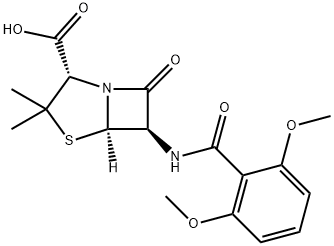2,6-Dimethoxyphenylpenicillin; methicillin (international
non-proprietary name). The first β-lactamase-resistant semisynthetic
penicillin. It was initially used widely but has been
superseded by other group 3 members and is no longer commercially
available.
It is less active than benzylpenicillin or other group 3
penicillins. It is very stable to staphylococcal
β-lactamase and is active against β-lactamaseproducing
strains of Staph. aureus that do not produce a
functional PBP 2a. Resistance is common among
staphylococci, with the incidence geographically diverse.
Most methicillin-resistant staphylococcal isolates display
multiresistance.
It is not acid resistant, and must therefore be administered
parenterally. About 10% is metabolized, with 60–80% of the
dose excreted in the urine. Toxicity is similar to that of other
group 3 penicillins. Nephritis appears to be more common
than with other penicillins.
Like other semisynthetic penicillins, methicillin exhibits an antibacterial effect similar to that
of benzylpenicillin. The main difference between methicillin and benzylpenicillin is that it is
not inactivated by the enzyme penicillinase, and therefore it is effective with respect to agents
producing this enzyme (staphylococci). It is used for infections caused by benzylpenicillin�resistant staphylococci (septicemia, pneumonia, empyemia, osteomyelitis, abscesses, infected
wounds, and others). Synonyms of this drug are cinopenil, celbenin, staphcillin, and others.
Methicillin, [2S-(2|á,5|á,6|?)]-3,3-dimethyl-7-oxo-6-(2,6-dimethoxybenzamido)-
4-thia-1-azabicyclo[3.2.0]-heptan-2-carboxylic acid (32.1.1.3), is synthesized by acylating 6-
APA with 2,6-dimethoxybenzoic acid chloride in the presence of triethylamine.


